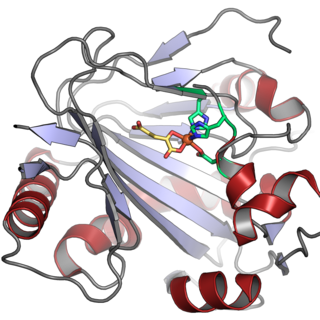In enzymology, a dihydrokaempferol 4-reductase (EC 1.1.1.219) is an enzyme that catalyzes the chemical reaction
In enzymology, a 2'-deoxymugineic-acid 2'-dioxygenase (EC 1.14.11.24) is an enzyme that catalyzes the chemical reaction
In enzymology, a 6β-hydroxyhyoscyamine epoxidase (EC 1.14.11.14) is an enzyme that catalyzes the chemical reaction
In enzymology, a deacetoxycephalosporin-C hydroxylase (EC 1.14.11.26) is an enzyme that catalyzes the chemical reaction
In enzymology, a deacetoxycephalosporin-C synthase is an enzyme that catalyzes the chemical reaction
In enzymology, a flavanone 3-dioxygenase (EC 1.14.11.9) is an enzyme that catalyzes the chemical reaction
In enzymology, a flavone synthase (EC 1.14.11.22) is an enzyme that catalyzes the chemical reaction
In enzymology, a flavonol synthase is an enzyme that catalyzes the following chemical reaction :
In enzymology, a gibberellin-44 dioxygenase (EC 1.14.11.12) is an enzyme that catalyzes the chemical reaction

In enzymology, a phytanoyl-CoA dioxygenase (EC 1.14.11.18) is an enzyme that catalyzes the chemical reaction
In enzymology, a proline 3-hydroxylase (EC 1.14.11.28) is an enzyme that catalyzes the chemical reaction
In enzymology, a taurine dioxygenase (EC 1.14.11.17) is an enzyme that catalyzes the chemical reaction.
In enzymology, a thymine dioxygenase (EC 1.14.11.6) is an enzyme that catalyzes the chemical reaction
In enzymology, a trimethyllysine dioxygenase (TMLH; EC 1.14.11.8) is an enzyme that catalyzes the chemical reaction
In enzymology, a leucoanthocyanidin reductase (EC 1.17.1.3) (LAR, aka leucocyanidin reductase or LCR) is an enzyme that catalyzes the chemical reaction

Leucoanthocyanidin (flavan-3,4-diols) are colorless chemical compounds related to anthocyanidins and anthocyanins. Leucoanthocyanins can be found in Anadenanthera peregrina and in several species of Nepenthes including N. burbidgeae, N. muluensis, N. rajah, N. tentaculata, and N. × alisaputrana.

Leucocyanidin is a colorless chemical compound that is a member of the class of natural products known as leucoanthocyanidins.
Clavaminate synthase (EC 1.14.11.21, clavaminate synthase 2, clavaminic acid synthase) is an enzyme with systematic name deoxyamidinoproclavaminate,2-oxoglutarate:oxygen oxidoreductase (3-hydroxylating). This enzyme catalyses the following chemical reaction
Pentalenolactone F synthase (EC 1.14.11.36, PEND (gene), PNTD (gene), PTLD (gene)) is an enzyme with systematic name pentalenolactone-D,2-oxoglutarate:oxygen oxidoreductase. This enzyme catalyses the following chemical reaction
Alpha-ketoglutarate-dependent hydroxylases are a major class of non-heme iron proteins that catalyse a wide range of reactions. These reactions include hydroxylation reactions, demethylations, ring expansions, ring closures, and desaturations. Functionally, the αKG-dependent hydroxylases are comparable to cytochrome P450 enzymes. Both use O2 and reducing equivalents as cosubstrates and both generate water.



